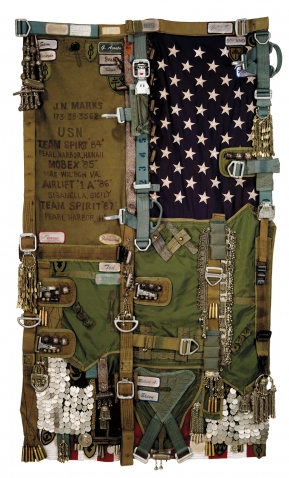Sara Rahbar, Dust and Ash|Flag #52, 2015, mixed media, 59 ⅞ in. by 37 in., museum purchase, the Maryam and Edward Eisler/Goldman Sachs Gives Fund on Art and Visual Culture in the Near, Middle, and Far East
Beginning in 2005, artist Sara Rahbar (b. 1976, Tehran, Iran) undertook what would become a multiyear series of mixed-media works based on the United States flag. The series now numbers over 50 works of art, and each unique composition embodies a complicated narrative of politics, aesthetics, and biography.
The American flag has a long, and sometimes controversial, history of use in art. Artists such as Jasper Johns, Faith Ringgold, and Keith Haring have each incorporated the distinct iconography of stars and stripes into their work to achieve various ends, harnessing the symbol to explore its minimalist graphic forms, critique social issues, or celebrate community events. Rahbar emigrated from Iran as a young child with her family and has lived and worked in New York for most of her life. She sets the American flag in dialogue with her own experience as an immigrant, resulting in a provocative body of work that presents a deeply complex and personal representation of national power.
Dust and Ash|Flag #52, completed in 2015, is among the last works in the series. The earliest flags included fragments of vibrant domestic textiles such as rugs, pillows, woven bags, and clothing. Rahbar subsumed the American flag’s red and white stripes with the chromatic exuberance and inventive patterns of Middle Eastern weaving, and revealed only the unmistakable blue field of white stars in the upper right corner of the composition. Dust and Ash includes the field of stars, yet incorporates none of the vibrant domestic textiles that distinguished the early works. Instead, the brown and olive-green palette of military gear dominates this later work. The long arc of Rahbar’s 15-year series manifests a shift in materials and aesthetic forms, from the warm luxury of home comforts to the darker fabrics of utility and war. Dust and Ash speaks to the artist’s changing engagement with international conflict and identity.
The artist describes the American flag as a “foundation” for every work in the series. The flag remains whole in each work, forming a literal—and potently metaphorical—support for the array of elements Rahbar collages on its surface. In Dust and Ash, the field of stars and the pattern of red and white stripes just visible along the bottom edge indicate the vertical presentation of the flag. In the upper left, Rahbar includes a large fragment of a soldier’s duffle bag, still bearing inscriptions that document the chronology and geography of his service. Several embroidered name patches, typically found on the shirts of blue-collar workers, also appear across the composition. Originally meant to assert a unique identity, they are here dislocated from the wearer’s uniform and made anonymous, and their accumulated presence invests a sense of collective purpose in Rahbar’s engagement with the American flag. Woven straps from bags, harnesses, and belts hint at the vertical geometry of the patriotic stripes beneath the surface. Rahbar uses Middle Eastern jewelry and coins, removed from their context of bodily adornment and daily transactions, to embellish the flag. Silver earrings and pendants glint among the shiny buckles of the military gear; their dangling forms echo groupings of bullet casings that also decorate Dust and Ash. Individually, the name patches, service inscriptions, and traditional jewelry hint at human intimacy, yet combined, they invest Rahbar’s flag with broad cross-cultural potential.
Rahbar often acquires her materials in person by browsing thrift stores and markets. She prefers to feel their worn life with her hands, and she is attuned to their quiet stories without ever knowing the specific details. Rahbar did not have a background in fiber arts when she began the series, and the American flag was the first textile she incorporated into her practice. Combining domestic and military elements from her two cultures, and using the American flag as a visible support, is cathartic for the artist. Describing the process as “piecing together a puzzle,” Rahbar offers an apt metaphor for the slow experience of constructing an identity from multiple homelands. For many people, the American flag is both an emblem of hope and a complicated political statement. In Rahbar’s work, the textiles and jewelry of American and Middle Eastern life come together to layer new stories over a powerful symbol of nationhood.








We ask that those who engage in Wellesley magazine's online community act with honesty, integrity, and respect. (Remember the honor code, alums?) We reserve the right to remove comments by impersonators or comments that are not civil and relevant to the subject at hand. By posting here, you are permitting Wellesley magazine to edit and republish your comment in all media. Please remember that all posts are public.